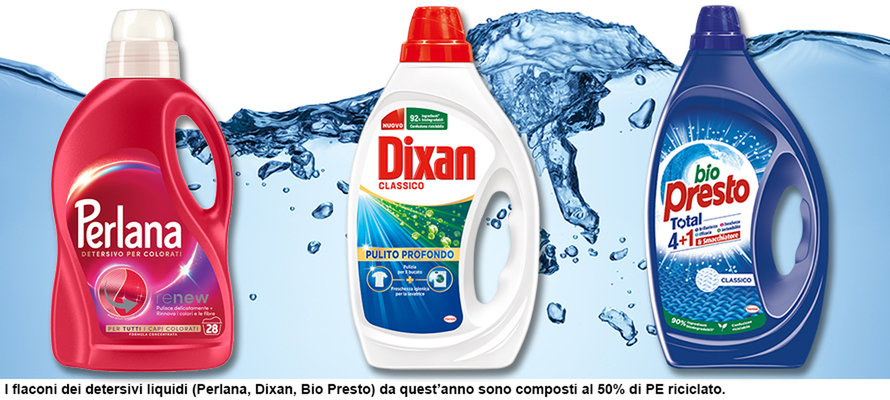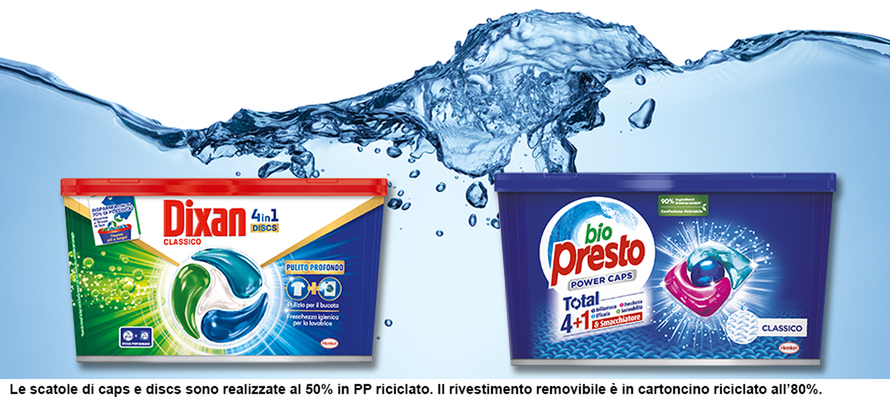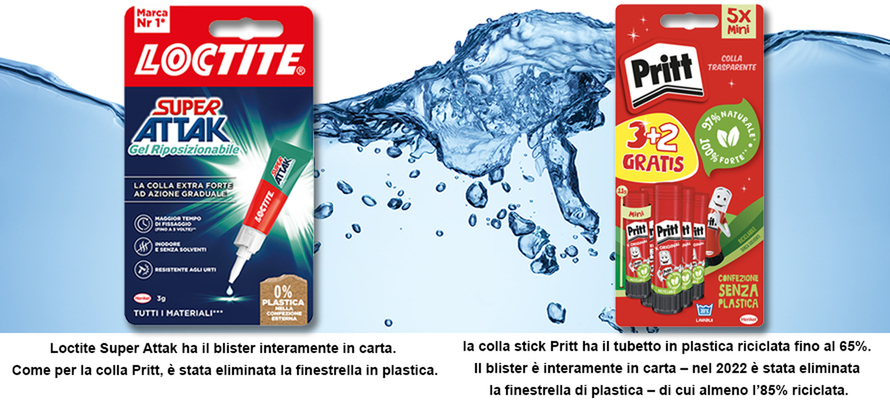Henkel, no innovation without sustainability
It was founded in Germany in 1876 and has been part of the family in Italian homes for 90 years. If its products were created to simplify people's lives, environmental and social sustainability has been part of its way of doing business from the beginning, evolving with the times and needs. Mara Panajia, President and CEO of Henkel Italia, tells us about this journey.
By Achille Perego | On PRINTlovers 101
It entered the homes of Italians just over 90 years ago. Since then, it has never left and has added to its household products - with leading brands such as Dixan (or Persil in many countries), Perlana, Pril, BioPresto, Nelsen, Vernel or Acchiappacolore - personal care brands, from hair products (Schwarzkopf) to adhesives such as Super Attak by Loctite and Pritt, the first glue stick in history launched in 1969.
These product names are perhaps better known - thanks in part to the television campaigns that have marked the history of advertising in Italy and, in some ways, also language and custom - than that of the German parent company: the giant Henkel. The company, founded in 1876 by Fritz Henkel - whose family still owns most of the shares - sold €21.5 billion worth of detergents, cosmetics and adhesives products worldwide and over €650 million in Italy in 2023. Even 40 years before the company was founded, in May 1893, Fritz Henkel wrote in a letter to his sales manager that he had "shipped the first 100 crates [of Bleich-Soda laundry detergent] to Italy". He hoped to "develop Italy as a sales market" since "the samples that arrived about eight days ago were a resounding success". The company was set up in Lomazzo (Como) as Società Italiana Persil in 1933 and grew to become an organisation that 2023 generated revenues of €650 million. It has more than 800 employees distributed between its Milan offices and plants in Ferentino (Frosinone), where it produces detergents for laundry and tableware, Casarile (Milan) and Zingonia (Bergamo), specialising in adhesives for industry. These sites were joined by the Adhesive Technologies application centre in Caleppio di Settala (Milan).
In these 90 years, Henkel has not stopped growing in Italy, focusing on the two pillars of innovation and sustainability—pillars that concern not only the products, i.e., the content of the packages, but also the container, i.e., the packaging, which sees Henkel among the world champions of use and on the front line of making it more sustainable.
"Ours is a story of small, major revolutions that have improved everyday life by making it easier to do the laundry, take care of your hair, express yourself or produce something," explains Mara Panajia, president and CEO of Henkel Italia since September 2022. Born in Calabria, cited in 2021 by Forbes as one of the 100 most successful Italian women, she began her career at Danone after graduating from Bocconi University. She joined Henkel in 2000, moving to the Düsseldorf headquarters in 2014, where she held the role of corporate vice president. She returned to Italy in 2018 "after five years," she says, "in which I commuted every week with my family in Milan" as General Manager of Laundry & Home Care, making a decisive contribution to the reorganisation of the division and the relaunch of the most significant brands.
Last year, the group launched an internal 'revolution' by announcing the new HCB-Henkel Consumer Brands division, which flanks the Adhesive Technologies division, bringing together the historic home care and personal care brands under one umbrella. "The new set-up, which accounts for about 50% of the business worldwide," explains Panajia, "includes a plan geared towards enhancing the main brands in the two categories: an approach that aims to maximise the success of a selected portfolio of products, to continue to respond effectively to new market trends. Similarly, the Adhesive Technologies division is constantly focused on innovating its offering to create increasingly sustainable and cutting-edge solutions for everyday products and large-scale industry in Italy. With our two divisions, in line with our strategy, we are continuing to shape a winning portfolio, keeping a strong and certain will to create and maintain a positive outlook towards the future: to do this, we invest in people, innovation and sustainability, values that have always been at the core of Henkel's DNA."
How much at the core?
"From the very beginning, Henkel has focused heavily on what is now called sustainability. Just think that as early as 1912, an internal first aid station was created, the safety protocol for workers was established in 1927, and the first company crèche was opened in 1940!"
How has this focus on sustainability values continued?
"Even in the last few years, which have been challenging from an economic and competitive point of view, we have managed not to retreat on environmental and social responsibility issues, in fact taking many steps forward along the road we have mapped out. Italy is making an essential contribution to achieving the goals set at a global level. We are accelerating the energy transition of our production sites and working to make our products more and more sustainable.”
Henkel is a big consumer of plastic for packaging: how sustainable are you in this sector?
"Already today, 87 per cent of our packaging is recyclable and reusable, and for some products, we have already reached the target, set for 2025, to use only recyclable plastics. I would also like to mention our courageous choices concerning consumer habits, such as the one taken in 2020 by turning the Nelsen dishwashing detergent bottle from white to transparent. But our commitment is not limited to environmental protection and also concerns our employees and the communities in which we operate."
Sustainability, after all, has been part of Henkel's way of doing business from the beginning. In its latest Sustainable Development Report, the company confirmed its commitment to becoming climate-positive by 2030, going beyond carbon neutrality, producing more clean energy than it consumes and thus generating a positive balance by 2023. As part of this journey, Henkel has increased the proportion of electricity from renewable sources currently used at its 161 production sites around the world to 89%, intending to achieve 100% by 2030. Compared to 2010, CO2 emissions per tonne of product decreased by 61 per cent, approaching the minus 65 per cent goal for 2025. The decarbonisation of production includes targeted investments to modernise energy-saving factories and, where possible, produce clean energy directly at Henkel sites. The company has renovated the spray drying tower in Italy at its Ferentino (Frosinone) site. It now produces detergent powder using 16 per cent less methane and 40 per cent less electricity, reducing CO2 emissions by 18 per cent. Several projects are also underway in Casarile (Milan). As more than 70 per cent of Henkel's overall carbon footprint is related to product use and packaging disposal, the company continues to invest in R&D to improve product formulations by offering the same or better performance with less use of energy and water and by integrating raw materials from renewable sources as much as possible. As mentioned, Henkel now boasts 87% recyclable or reusable packaging, intending to reach 100% by 2025, and wants to increase the share of recycled plastic in consumer product packaging to 30% by 2025. Currently, the average percentage is 19%, but several well-known makes with 100% recycled plastic bottles are already on the market. By 2025, 100% of the paper and cardboard used in packaging will be recycled or renewable.
The aim, therefore, is to exceed new goals on the packaging sustainability front, which in the last 30 years has seen significant steps such as the launch of the first Dixan bottles made of recycled plastic in 1992, the introduction of Braille on detergent packaging in 2009 (the first company in the detergent sector to do so), the complete elimination of microplastics from cosmetic products in 2016, and the launch of plastic-free Pritt packaging in 2022. In particular, this packaging strategy is based on three pillars. The intelligent design of packaging with the reduction of its material by aiming by 2025 to use only packaging that has all the properties necessary to enter a recycling or reuse process. So, in other words, the use of materials from renewable sources, such as paper and cardboard, entirely from recycled materials or, where virgin fibre is required, material from sustainably managed and certified forests. Finally, the third pillar concerns 'closing the circle together'. This is why Henkel works with companies along the value chain to promote progress in the recycling infrastructure and is developing and testing new logos for product packaging to promote sustainable purchasing habits and communicate how to recycle correctly. There are many examples of packaging designed with suppliers for proper sustainability. For instance, Loctite's new heat seal coating solution has opened the door to new sustainable solutions, replacing PE (polyethylene) film with paper in primary and secondary packaging of various products, from hygiene to food to industrial equipment. The packaging of all Pritt and Loctite Super Attak glues is also made exclusively from 100% recyclable paper and cardboard, with the knowledge that having single-material packaging is one of the critical aspects of simplifying recycling. For laundry, home care and hair care products, recycled plastic has been integrated into the bottles of several famous makes such as Vernel Concentrate, Nelsen Concentrate, Bref Spray and Biopresto hand spray, now made of 100% recycled PET plastic. The bottles and the sleeves that cover them are made of two different plastics, which must be separated before being put in the recycling bin to be sent to their respective recycling processes. To this end, Henkel has made it easier to remove the shrink labels.
From this year, the packaging of Bio Presto - chosen by the Ministry of Enterprise and Made in Italy as one of the historical brands in the exhibition 'Identitalia, The Iconic Italian Brands' - Perlana and Dixan are 50% recycled PE and the caps/discs boxes 50% recycled PP with the removable cover in 80% recycled cardboard. Gliss shampoo and Aqua Revive moisturising serum have packaging made of 100% recycled plastic, as does Gliss conditioner spray express Seta Luminosa, while Coloreria Italiana boasts packaging made of 50% recycled PP plastic. Finally, the sustainable choices made for packaging adhesives and sealants are also significant. The famous Pritt glue stick has a tube made of up to 65% recycled plastic and the blister entirely of paper, at least 85% of which is recycled. In 2022, the plastic 'window' was also eliminated. The blister of Loctite Super Attak Gel is also made entirely of paper. At the same time, in February of this year, Henkel took another step forward regarding environmental sustainability by announcing the new Pattex cartridges made of up to 95% post-consumer recycled plastic. The recycled cartridges for Pattex Pro sealants are already available in Italy. They will be gradually introduced for MilleChiodi assembly adhesives and do-it-yourself sealants to complete the green transition by next autumn.








